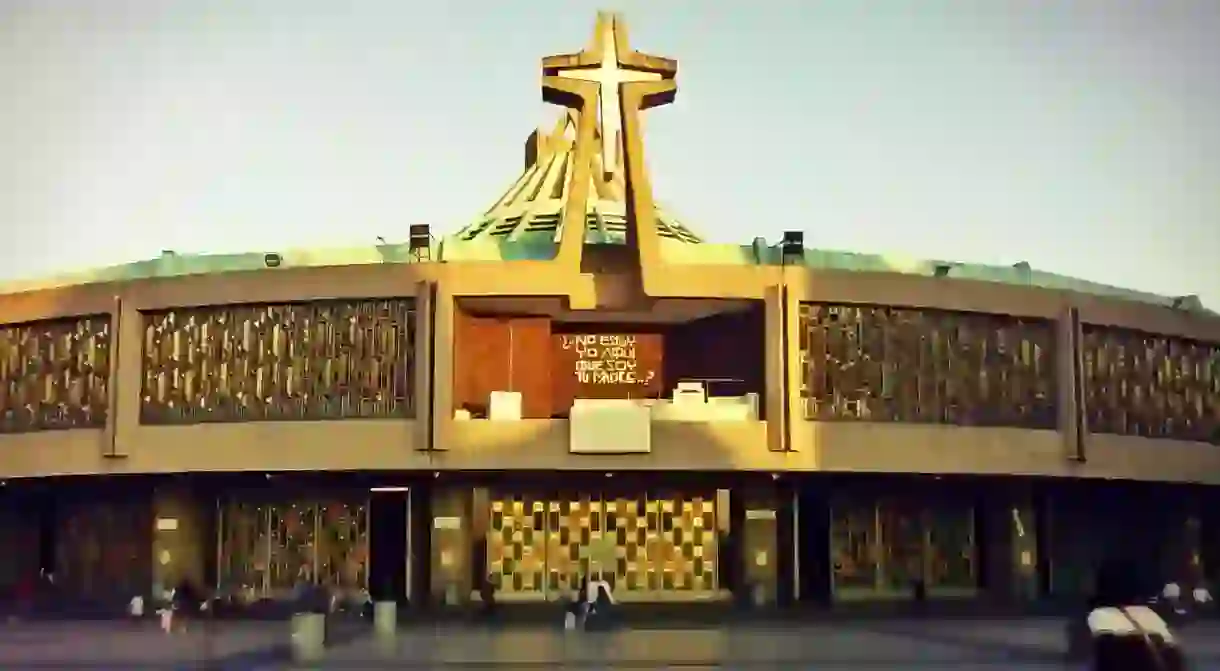Everything You Need to Know About the Basilica De Guadalupe in Mexico

Visitors to Mexico City will soon recognise the figure associated with this church: whether on souvenirs, tattoos or posters, the Virgen de Guadalupe is the Queen of Mexico and the Empress of the Americas. Nowhere is her cult as strong as at the Basilica de Guadalupe, built in her honor and now one of the most visited religious sites in the world. Here’s everything you need to know.
Background
Legend has it that a baptized Aztec Indian named Juan Diego was walking on the hill of Tepeyac in the dead of winter, when he saw the apparition of young girl. She asked him to visit the local bishop and tell him that the Virgin Mary wanted a church built in her honor on the hill. Juan Diego did what he was told, visiting the local archbishop several times, but each time the bishop rejected his story.
Upon Juan Diego’s last visit to the hill, Mary told him to go gather roses in a different part of the hill – roses that could not possibly be growing at this time of the year. To his surprise, the roses where exactly where she said, and he gathered them up in his tilma (a cloak-like poncho) and carried them to the bishop. When he laid the flowers at the feet of the bishop, the front of his tilma was adorned by the image of the now-famous Virgin de Guadalupe, and the bishop was convinced of the miracle of her sighting.

Teotihuacan, Guadalupe Shrine, Tlatelolco & Tequila Tasting
Cathedral, Library, Museum
An indigenous Virgin
The area where the basilica is built had long been a sacred place in for the Mexica peoples of Mexico. When the Spanish conquered Mexico, local people were forbidden to visit a pagan shrine that sat atop the Tepeyac hill. At this particular sighting (there have been many throughout the world) the young woman spoke to Juan Diego in his native tongue and she was dark-skinned. This added to her allure for the local Aztecs and many were baptized Catholic as a result of her appearance to one of their own.
The building of the basilica
In 1660 the first chapel-shrine to the Virgin of Guadalupe was built on the higher reaches of the Tepeyac hill. This small chapel, which can still be visited today, is known as the Capilla del Cerrito, and marked the miracle until the first basilica was built in the Virgin’s honor in 1695. This second structure remained the home of Juan Diego’s famous tilma until the 1970s when after centuries of remodeling, and extensive damage caused by the sinking ground beneath the basilica, a new basilica was built to one side of the same plaza.

A new home for the Virgin of Guadalupe
The New Basilica, as it is called, was built from 1974-1976 by Pedro Ramírez Vásquez. The building has a 1970s feel and looks a bit like an old-fashioned revival tent from the American south, with seven entryways that represent the seven gates of Celestial Jerusalem referred to in the Bible. On the grounds surrounding this church are also the remaining buildings of the ex-convent of the Capuchina nuns, as well as a museum about the basilica and various other small chapels, including one dedicated to Juan Diego. The entire complex is referred to as La Villa Basilica.
Full-Day Teotihuacan & Basilica Guadalupe Tour
Cathedral, Library, Museum
A procession of pilgrims
Non-Catholic visitors to Mexico City might not have the basilica very high on their list, but the basilica and its story are an important part of Mexico’s history and continue to be integral to the daily lives of local citizens and visiting pilgrims. Each year it is believed that 20 million people visit the basilica, and 9 million of those come for the Virgin of Guadalupe’s feast day on December 12. Oftentimes you will see dedicated pilgrims crawl from the door to the front altar on their knees.

A glimpse of the Virgin
Up to 30 masses a day can be held at the basilica, and pilgrims stand in long lines to join the procession of three moving sidewalks that pass in front of Juan Diego’s tilma, now protected by bulletproof glass. Devotees offer up prayers, bless babies and light candles in honor of the blessed Virgin. They often bring items and trinkets that they then have blessed by a local priest. Outside the basilica is a separate stand, a kind of drive-through blessing, for those short on time or who aren’t able to go inside.
Blessed commerce
As with most tourist attractions in Mexico, there’s a lot of souvenir shopping to be done at the basilica. Vendors sell snacks, aguas frescas and ice cream to parched pilgrims, while a row of shops to one side of the plaza (at sidewalk level) sell statues, t-shirts, crucifixes, candles, necklaces, posters, calendars and anything else you might want as a keepsake memento of your visit. The streets that surround the basilica are teeming with street food vendors and small mom-and-pop restaurants where you can grab hearty (cheap) lunch.

Getting to the church on time
La Villa Basilica can be reached by taking the Mexico City metro Line 6 to the ‘La Villa Basilica’ stop and then walking several blocks to the plaza or by taking the Metro Bus Line 1 to its end at Indios Verdes and walking from there. You can also take a taxi from anywhere in the city and simply tell your cabbie to take you to “La Villa.” As it’s the most visited Catholic site in the world, they’ll know how to get there.

Teotihuacan & Basilica Guadalupe Tour with lunch
Cathedral, Library, Museum













